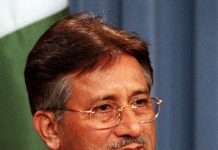By Muhammad Luqman
Pakistan is ahead of India in terms of nuclear arsenal with 140-150 warheads as compared to 130-140 possessed by New Delhi, with China having 280, according to latest report of the Stockholm International Peace Research Institute (SIPRI).
World’s nuclear powers are reducing their arsenals but they are also modernising, putting a fresh and “worrying” focus on strategic deterrence.
“The renewed focus on the strategic importance of nuclear deterrence and capacity is a very worrying trend,” the SIPRI report said.
SIPRI, a well respected authority on weaponry and defense, said nine countries — the United States, Russia, Britain, France, China, India, Pakistan, Israel and North Korea — had 14,465 nuclear warheads at the beginning of the year 2018 against 14935, of which 3,750 were actually deployed.
United States and Russia hold more some 92 percent of total warheads, SIPRI noted, and they both have long-term modernisation programmes in place.
Russia in particular has in recent years re-stated the importance of nuclear weapons to its strategic defence, sparking concerns in NATO that Moscow might be more willing to use them in a crisis.
The nuclear arsenals of the other nuclear-armed states are considerably smaller, but all are either developing or deploying new nuclear weapon systems or have announced their intention to do so. India and Pakistan are both expanding their nuclear weapon stockpiles as well as developing new land-, sea- and air-based missile delivery systems. China continues to modernize its nuclear weapon delivery systems and is slowly increasing the size of its nuclear arsenal.
At the same time, Britain with 215 warheads, France 300, China 280, India 130-140, Pakistan 140-150, Israel 80 and North Korea 10-20, were all either deploying or planning to deploy new nuclear weapons system, it said.
“North Korea also demonstrated unexpected rapid progress in the testing of two new types of long-range ballistic missile delivery systems,” it noted.
In 2017 North Korea continued to make technical progress in developing its nuclear weapon capabilities, including the test of—what was claimed to be—a thermonuclear weapon, in September. North Korea also demonstrated unexpected rapid progress in the testing of two new types of long-range ballistic missile delivery systems.















